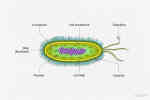Step 3 of 5•5 minutes read
Bacterial Multiplication and Survival
Food poisoning bacteria are commonly found in raw food so as a supervisor you need to understand that it is impossible to eradicate them 100% in the food environment. So the food safety management system is designed to deny bacteria to multiply to levels that will make passengers and crew sick. Bacteria can only be observed under a microscope.
The image below shows the structure of bacteria. As you can see, it's a fairly complex organism and it fights to survive and multiply like any other organism on the planet. Although they can not be seen unless, under a microscope, they are nevertheless strong and determined to keep surviving.
The cell wall gives the bacteria its rigid shape and structure. The cell membrane controls the passage of waste into and out of the cell wall. The cytoplasm is like the bacteria's body with the nucleoid DNA being the brain. The flagellum allows the bacteria to move around in liquids but generally, the bacteria rely on food, hands or equipment to move around. These are known as vehicles.

Structure or Bacteria
Some bacteria can multiply every 10 minutes by dividing into 2, known as binary fission or asexual reproduction. That means 1 bacteria becomes 2 and then 2 becomes 4 .. so on and so on!
Below are the numbers from just one bacteria dividing every 10 mins for 2 hours when the conditions are ideal for them. Imagine the numbers with many more bacteria present in perfect conditions.
1 = 2 = 4 = 8 = 16 = 32 = 64= 128 = 256 = 512 = 1,024 = 2,048!!
This is why time is important in controlling the multiplication of bacteria in food. Reduce the amount of time kept in the danger zone. The danger zone is 5-63°C.
This is a video showing you how bacteria divide. This bacteria is an example of one that divides every 20 mins but some are every 10 mins!
The rate of bacterial growth is determined by 4 stages as shown in the diagram below. The rate is very dependent on having the right conditions of food, time, themperature and moisture. This will help you understand why it's important to control food in the lag phase: in the fridge, freezer, dried or preserved.

Stages of Bacterial Growth
Some pathogenic bacteria put up a fight to survive. The main ones in food safety are Clostridium perfringens, Bacillus cereus and Clostridium botulinum.
It's important you understand how they do this so you recognise the steps in the cooking, cooling, reheating and holding of food before service that could put crew and guests at risk.
The video below explains how some pathogenic bacteria form spores to protect themselves when conditions become difficult for them to survive.
To prevent bacteria from forming spores and becoming a food safety issue, the best practice is to avoid preparing food too far in advance. "Ideally Cook & Serve" immediately.
If time and operation require preparing in advance it is vital to cool food rapidly to below 5°C and reheat quickly once only to above 75°C.
Temperature-controlled buffets (both hot and cold) keep food out of the danger zone and ensure food is safe to eat.